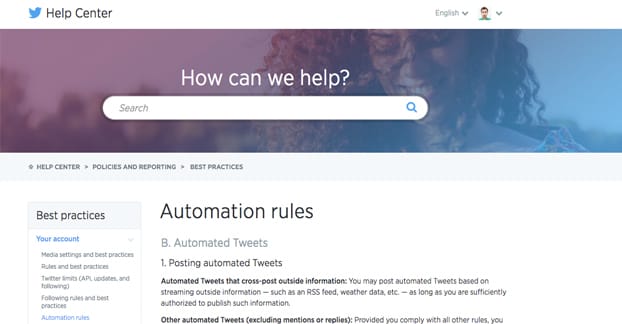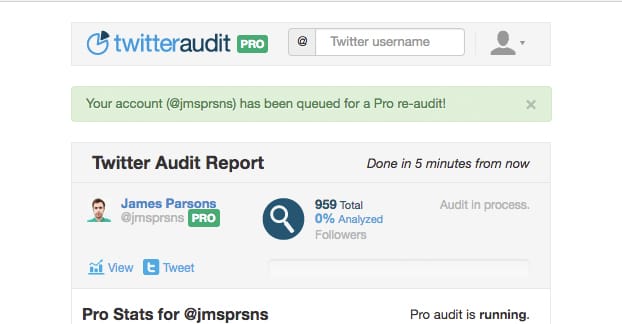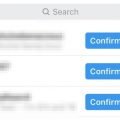Twitter is an interesting social network in that it promotes certain kinds of bot accounts while rejecting the existence of others. Some bots are good, like MagicRealismBot, which posts vaguely odd magical extensions of realistic situations as a sort of fiction experiment, Pentametron, which retweets casual tweets that happen to be in iambic pentameter, and CongressEdits, which posts when an IP address from a member of the U.S. Congress edits an article on Wikipedia.
On the other hand, I don’t have to tell you that bots running fake accounts – like the ones that do nothing but promote spam porn sites or just try to farm follow-backs to sell the account later – are obviously banned on sight.
There are two differences between the former and the latter. The first is that the former will actually follow someone, and when they do, it’s generally because the creator of the bot wants to support a similar bot or a related product. I wrote more about bots like that here.
The second difference comes down to Twitter’s rules on automation.
Twitter allows automation, even the complete automation of a bot, on the condition that the bot aims to provide value. In some cases, the value provided is something educational or entertaining, like the examples I listed above. In some cases, the value is more direct, like the defunct bot that would calculate Uber fares when you tweeted it two locations.
Bots that exist solely to be fake followers or spambots are harmful to Twitter’s social ecosystem, and they are subject to bans whenever Twitter spots one and decides to take action. This can mean Twitter bans the account, the IP, or even the app that’s causing the accounts to act the way they are.
Now, anyone who has run a Twitter account for more than a few months knows that fake followers will sometimes just show up, even if you don’t reach out to buy them or do anything to try to get them. Bots will react when you tweet certain keywords, even if it’s not in the right context. I tweeted the phrase “serious business” as part of a joke and had 8 marketing accounts follow me within an hour, for example.
You can take the time to monitor your followers every day, checking on every new follower that comes in and auditing them to see if they’re real or not. That’s fine, but when you’re growing quickly, you can easily miss a few or just end up spending hours working on the task.
Alternatively, you can simply catch the obvious bots and then use audit apps to do the rest. One such audit app is Twitter Audit. The only question is, how accurate is it?
How Twitter Audit Works
Twitter Audit does not explicitly find fake followers. Rather, the app scans your followers and looks for any follower that is considered low quality. What does low quality mean in this context?
- The follower could be an “egg” account, though Twitter removed the egg default avatar, and is otherwise inactive aside from following users.
- The follower could be an obvious fake, either with tweets that indicate spam or a profile that matches what spam bot accounts usually look like.
- The follower could simply be old and abandoned; accounts that haven’t tweeted in years are generally considered low quality, even though they’re real.
Twitter Audit scans your followers and flags the ones that look low quality. They then present you with a graph of your average quality score per follower and the “real points” per follower. They don’t provide information about what is considered an indication of realness or fakeness, though, so I can’t really tell you specifically what counts and what doesn’t.
In order to use Twitter Audit, you need to authorize the app. Doing so allows it to pull your list of followers by API, and analyze them. You can see the audits performed on other accounts, though if that account has not been analyzed before, the site will need to actually perform the audit.
It’s worth noting that an audit can be out of date. The site audits an account once, and saves that audit indefinitely. You cannot update the audit without investing in a Pro account, which comes in three flavors; Bronze, Silver, and Gold. All three pro accounts allow you to block fake followers, hide your audit if you don’t want it to be public, improve your score by marking followers as real if they were misflagged, and perform repeated audits.
So what’s the difference between the free account and the three tiers of pro accounts, if the only tangible difference between free and pro is repeated audits? Well, it comes down to knowing the mechanics of how a site like Twitter Audit does their audits.
How Auditing Works
Twitter Audit uses data samples to do their work. For those of you who know data science, that’s both to be expected and perfectly enough explanation. For the rest of you, here’s the scoop.
For any Twitter account under 5,000 followers, Twitter Audit will pull the complete list of followers and will audit all of them. For accounts over 5,000 followers, Twitter Audit will take a sample of 5,000 users.
So how accurate is Twitter Audit? Assuming they have a 100% accuracy on their identification of whether or not an account is fake – which they don’t – it will be 100% accurate for small accounts. From there, the scale gets a little worse. An account with 5,001 followers would have a very small margin of error, given that only one account is left out of the audit. An account with 10,000 followers would have a larger potential margin for error.
I don’t pretend to know how statistics work, but a sample size of 5,000 can be fine or it can be far too small, depending on the full size of the account. An account with 10,000,000 followers isn’t going to be significantly analyzed by a sample size of 5,000. Generally, the threshold for statistical significance is 5%.
Bringing things back around, the Pro version of Twitter Audit increases the number of followers it analyzes. The Bronze level is 10,000, the Silver version is 100,000, and the Gold version is unlimited. The pricing for the three is $5, $15, and $30 per month respectively.
So, if you take 5% as a guideline, the threshold for each tier to be statistically significant would be:
- Free: Accounts with up to 100,000 followers should be reasonably accurately analyzed.
- Bronze: Accounts with up to 200,000 followers should be reasonably accurately analyzed.
- Silver: Accounts with up to 2,000,000 followers should be reasonably accurately analyzed.
- Gold: Any account should be analyzed accurately.
So think about it this way. Any account under 100,000 followers can be analyzed with a statistically significant sample with the free version of the account. However, with the free Twitter Audit, you can’t see which accounts are labeled fake, and you can’t take action directly. You can simply see a percentage and a few graphs that don’t really give you much information.
For any larger account, or if you want a total scan of all of your followers, you will need to pay for an account. However, given that paid accounts can be cancelled at any time, you can consider it a one-time fee for a month of auditing if you so desire. Pay the $30, get a total scan of your entire Twitter account, take action to get rid of the fake followers and flag the good followers it flagged unnecessarily, and cancel the account.
Is Twitter Audit Useful?
If you’re just looking for an idea of whether or not your account has a lot of fake followers, Twitter Audit can be perfectly fine. It’s not going to give you tools to deal with those fakes, but it will tell you if you have a normal number of fakes (under 10% or so). It will also show you the opposite: if over 10-15% of your followers are fake, you might have an issue you should deal with.
If you pay for an account and thus are able to flag accounts properly and block the fakes, you stand to gain some value. Blocking fake accounts will remove them from your follower list, and will prevent them from following you or seeing your content in the future, though chances are they won’t bother with either.
While you block these followers, you can also manually go and report them. It’s tedious to do so, but it can help Twitter by removing those accounts rather than just letting them sit around. This can hurt the people who sell fake follows, at least by forcing them to make more accounts.
Alternatives to Twitter Audit
If you don’t like Twitter Audit specifically, but you still want to audit your Twitter followers with some kind of automatic tool, here are a few other options you can try.
1: Fake Follower Check from StatusPeople. This tool works in much the same way, though it has a slightly different definition of what constitutes a fake account and thus will come up with a different indication of fake followers than Twitter Audit. They also only take a sample size of 1,000 followers, meaning it’s only statistically valid for smaller accounts.
They do list inactive followers as a different category from fakes, so they aren’t lumped together they way they are with Twitter Audit. They also show you your fakes up front, or at least a few of them. They tell you what percentage follow very few users, what percentage speak English, and what percentage have not tweeted for over 100 days. Their premium versions of the app offer more features, like tracking multiple accounts, advanced metrics on followers, and automatic blocking. They have two versions, one for $5.50 per month and one for $15 per month.
2: Bot Or Not. This one is a simpler version of the above. It doesn’t do much that’s unique besides not give any details to people casually looking at their site, and ask for an email to access despite being able to pull it from the linked Twitter account.
3: Botometer. This one is a slightly different take on the service. Rather than analyzing all of your followers, it analyzes a specific account to see whether or not it’s likely to be fake. It’s a more detailed analysis, but it’s not really a bulk tool. It’s a project made by the Indiana University Network Science Institute and the Center for Complex Networks and Systems Research. You can check a user, check the followers of a user, and check your friends.
This one is actually a slow tool to use. When you want to scan all of your followers, it does so by pulling the list and then scanning them one single account at a time. It also has some fickle criteria; on my test account, it flagged a legitimate business account as 95% likely to be spam, but an actual spam account as only 65% likely to be spam. Interestingly, it also picked up a couple of accounts that were already suspended and no longer followed my account. I’m not sure where it got them. On top of all of that, it didn’t scan all of the followers on the account.
You can click an individual follower to see an expanded view of their data, including the sentiment and content analysis of their tweets, how connected they are to you and your network, and options to see their profile, block them, tweet at them, or view even more details.
There are also alternative services for other sites. Facebook doesn’t have one, since they make it impossible to see the followers of a page, and have no API for analyzing them. Instagram has options like Followercheck.co and FameAudit.com. I’ll save looking them over for another time.










So Twitter Audit says I only have 3 real followers out of 1000. I know for a fact that it is totally inaccurate. The “audit” is a joke! Fake Status says i have 8% fake followers…what is interesting I know for a fact after looking who the “8% fakes” were that 50% are absolutely real people that I personally know, who at best have been inactive. The other 50% I am not sure whether they are real or not. All of this is bogus crap to get you to spend money on something that has zero value.
So Internetdoctor, did you at any time ever buy followers? If so, and someone conducted an audit of your followers then the sample it chose could have been most of those bought followers. That percentage of real/fake followers will follow you around until someone re-audits your account. The way to fix this would be to remove the fakes and then pay the fee and re-audit. If you use Twitter Audit to remove the fakes you should end up with 100% real followers. Therein lies the problem with Twitter Audit. A spammer can do this, get that ‘100% real’ and then buy more fakes. Until someone re-audits them they will keep that 100% value.